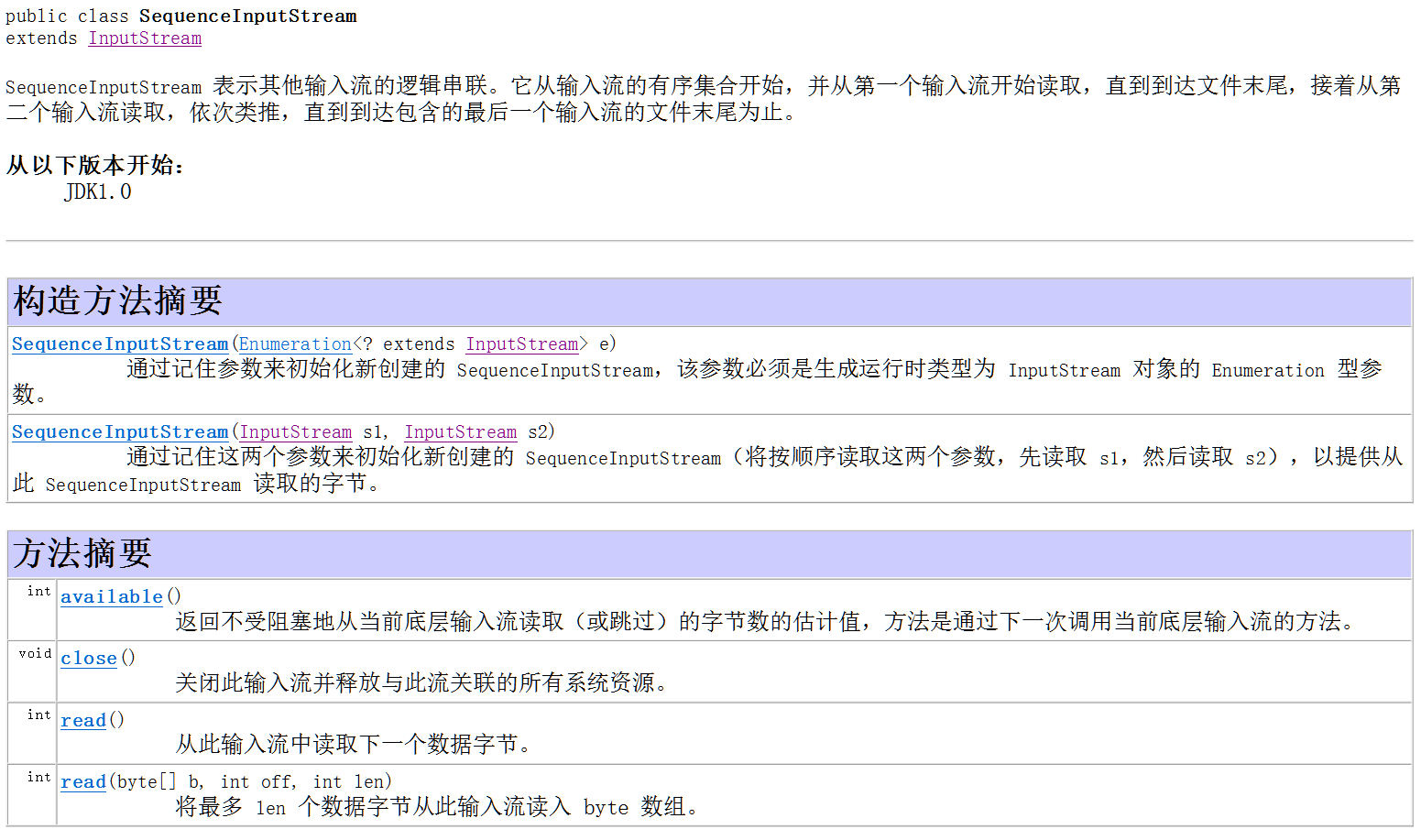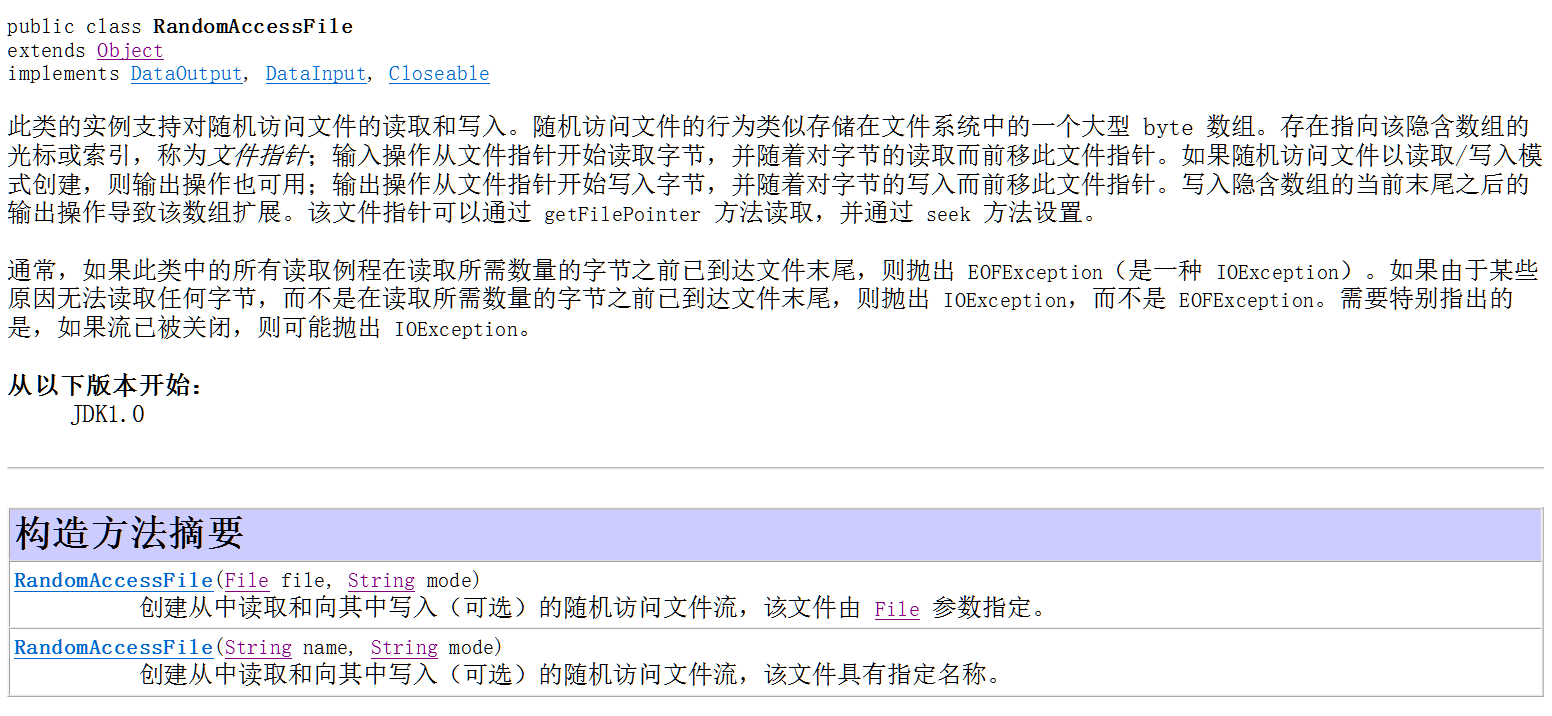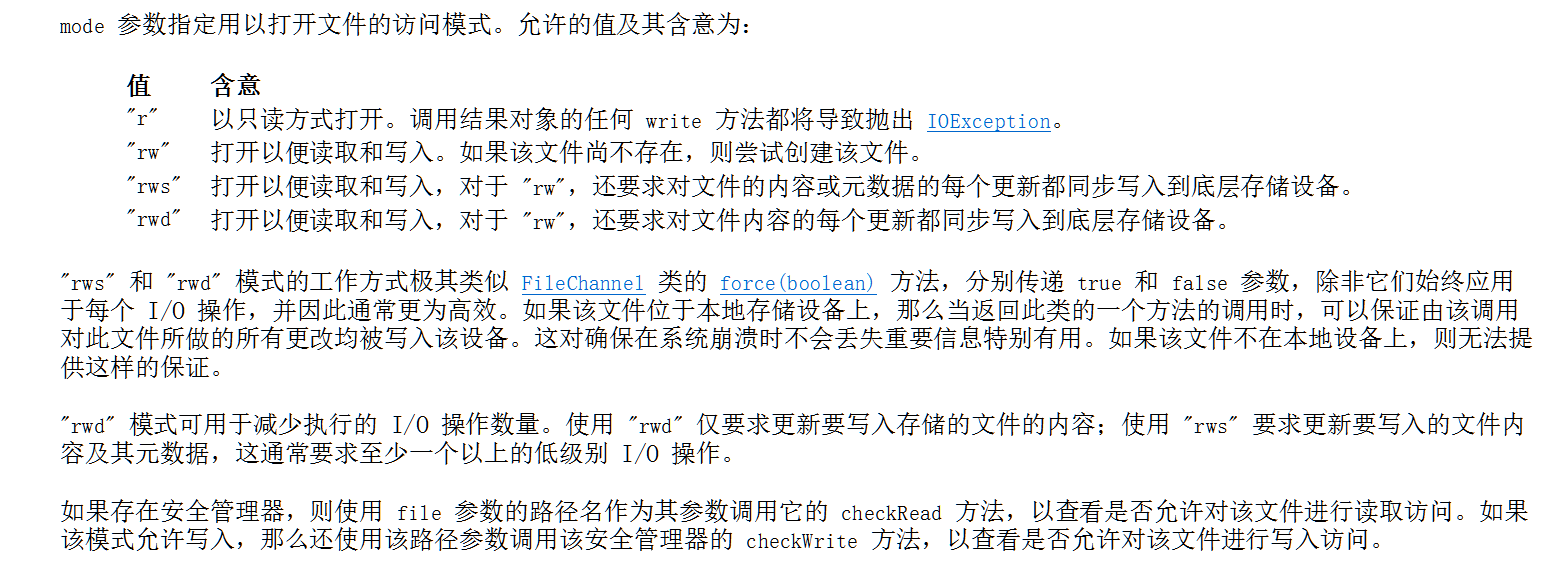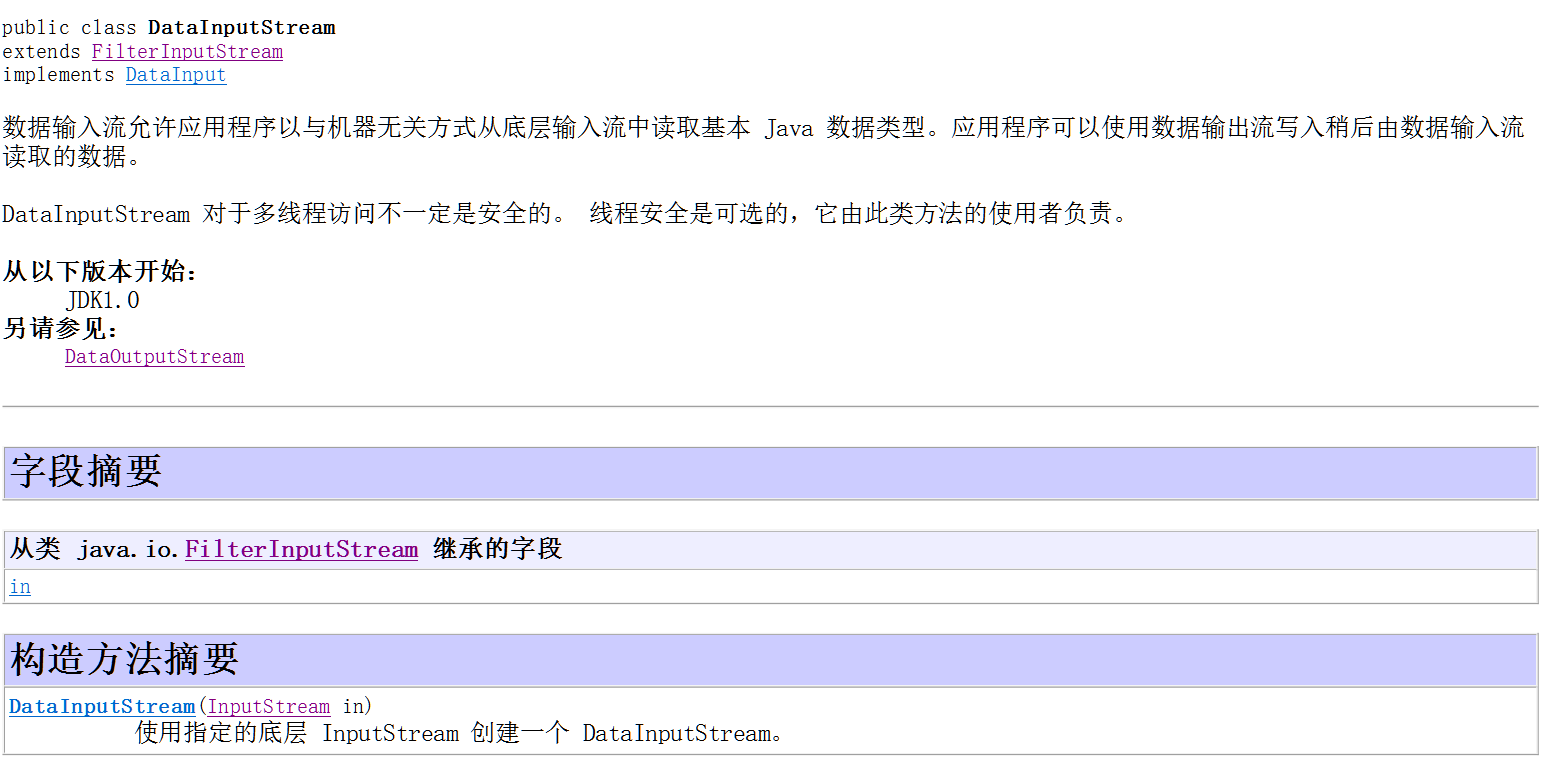Java I/O流 04
I/O流·其他流
序列流
* A:什么是序列流
* 序列流可以把多个字节输入流整合成一个,从序列流中读取数据时,将从被整合的第一个流开始,读完后再读下一个
* B:使用方式
* 整合两个:SequenceInputStream(InputStream, InputStream)
* 整合多个:SequenceInputStream(Enumeration)


package com.heima.otherio; import java.io.FileInputStream; import java.io.FileNotFoundException; import java.io.FileOutputStream; import java.io.IOException; import java.io.SequenceInputStream; import java.util.Enumeration; import java.util.Vector; public class Demo1_SequenceInputStream { public static void main(String[] args) throws IOException { // demo1(); // 不用序列流的方法 // demo2(); // 整合两个输入流 // demo3(); // 整合多个输入流 } public static void demo3() throws FileNotFoundException, IOException { FileInputStream fis1 = new FileInputStream("a.txt"); // 创建字节输入流 FileInputStream fis2 = new FileInputStream("b.txt"); FileInputStream fis3 = new FileInputStream("c.txt"); Vector<FileInputStream> v = new Vector<FileInputStream>(); // 创建泛型为字节输入流的集合对象 v.add(fis1); // 将流对象添加到集合内 v.add(fis2); v.add(fis3); Enumeration<FileInputStream> e = v.elements(); // 根据Vector集合,创建泛型为字节输入流的枚举对象 SequenceInputStream sis = new SequenceInputStream(e); // 将枚举中的输入流整合成一个 FileOutputStream fos = new FileOutputStream("d.txt"); // 创建字节输出流 int c; while ((c = sis.read()) != -1) { // 从序列流中读取数据 fos.write(c); } sis.close(); // 关闭序列流 fos.close(); } public static void demo2() throws FileNotFoundException, IOException { FileInputStream fis1 = new FileInputStream("a.txt"); // 创建字节输入流1 FileInputStream fis2 = new FileInputStream("b.txt"); // 创建字节输入流2 SequenceInputStream sis = new SequenceInputStream(fis1, fis2); // 基于两个字节输入流,创建序列流 FileOutputStream fos = new FileOutputStream("c.txt"); // 创建字节输出流 int b; while ((b = sis.read()) != -1) { // 从序列流读取数据 fos.write(b); } sis.close(); // sis在关闭的时候会将构造方法中的流对象也都关闭 fos.close(); } public static void demo1() throws FileNotFoundException, IOException { FileInputStream fis1 = new FileInputStream("a.txt"); // 创建字节输入流,关联a.txt FileOutputStream fos = new FileOutputStream("c.txt"); // 创建字节输出流,关联b.txt int c; while ((c = fis1.read()) != -1) { // 不断地在a.txt上读取字节 fos.write(c); // 将读到的字节写到c.txt上 } fis1.close(); // 关闭字节输入流1 FileInputStream fis2 = new FileInputStream("b.txt"); // 创建字节输入流,关联c.txt while ((c = fis2.read()) != -1) { // 不断地在b.txt上读取字节 fos.write(c); // 将读到的字节写到c.txt上 } fis2.close(); // 关闭字节输入流2 fos.close(); // 关闭字节输出流 } }
内存输出流
* A:什么是内存输出流
* 该输出流可以向内存中写数据,把内存当作一个缓冲区,写出之后可以一次性获取所有数据
* B:使用方法
* 创建对象:new ByteArrayOutputStream()
* 写出数据:write(int), write(byte[ ] )
* 获取数据:toByteArray()


package com.heima.otherio; import java.io.ByteArrayOutputStream; import java.io.FileInputStream; import java.io.FileNotFoundException; import java.io.IOException; public class Demo2_ByteArrayOutputStream { public static void main(String[] args) throws IOException { // demo1(); // demo2(); } public static void demo2() throws FileNotFoundException, IOException { FileInputStream fis = new FileInputStream("e.txt"); ByteArrayOutputStream baos = new ByteArrayOutputStream(); // 在内存中创建了可以增长的内存数组 int b; while ((b = fis.read()) != -1) { baos.write(b); // 将读取到的数据逐个写到内存中 } byte[] arr = baos.toByteArray(); // 将缓冲区的数据全部或取出来,并赋值给arr数组 System.out.println(new String(arr)); System.out.println(baos.toString()); // 将缓冲区中的内容转换为字符串,使用平台默认的码表转换 fis.close(); // baos.close(); // 内存流不需要关,没有关的意义 } public static void demo1() throws FileNotFoundException, IOException { FileInputStream fis = new FileInputStream("e.txt"); byte[] arr = new byte[4]; int len; while ((len = fis.read(arr)) != -1) { System.out.println(new String(arr, 0, len)); } fis.close(); } }
面试题
* 定义一个文件输入流,调用read(byte[ ] b)方法,将 a.txt文件中的内容打印出来(byte数组大小限制为5)

package com.heima.test; import java.io.ByteArrayOutputStream; import java.io.FileInputStream; import java.io.IOException; public class Test1 { /* * 分析: * 1、read(byte[] b)是字节输入流的方法,因此需要创建FileInputStream,关联a.txt * 2、创建字节数组,长度为5 * 3、创建内存输出流,将读到的数组写到内存输出流中 * 4、将内存输出流的数据全部转换为字符串打印 * 5、关闭输入流 */ public static void main(String[] args) throws IOException { FileInputStream fis = new FileInputStream("a.txt"); // 创建字节输入流,关联a.txt ByteArrayOutputStream baos = new ByteArrayOutputStream(); // 创建内存流 byte[] arr = new byte[5]; int len; while ((len = fis.read(arr)) != -1) { // 通过长度为5的数组读取数据 baos.write(arr, 0, len); // 将数据写入内存中 } System.out.println(baos); // 将内存中的内容以字符串的形式打印 fis.close(); // 关闭字节流 } }
对象操作流ObjectOutputStream
* A:什么是对象操作流
* 该流可以将一个对象写出,或者读取一个对象到程序中,也就是执行了序列化和反序列化的操作
* 对象需要实现序列化接口,可以可选择的重写ID号,类似于软件的版本号
* B:使用方法
* 写出:new ObjectOutputStream(OutputStream), writeObject()


package com.heima.bean; import java.io.Serializable; public class Person implements Serializable{ /** * 对象必须实现 可序列化接口 */ private static final long serialVersionUID = 2L; private String name; private int age; private String gender; public Person() { super(); } public Person(String name, int age) { super(); this.name = name; this.age = age; } public String getName() { return name; } public void setName(String name) { this.name = name; } public int getAge() { return age; } public void setAge(int age) { this.age = age; } @Override public String toString() { return "Person [name=" + name + ", age=" + age + "]"; } }

package com.heima.otherio; import java.io.FileNotFoundException; import java.io.FileOutputStream; import java.io.IOException; import java.io.ObjectOutputStream; import java.util.ArrayList; import com.heima.bean.Person; public class Demo3_ObjectOutputStream { public static void main(String[] args) throws IOException, IOException { // demo1(); // demo2(); } public static void demo2() throws IOException, FileNotFoundException { Person p1 = new Person("张三", 23); Person p2 = new Person("李四", 24); Person p3 = new Person("王五", 25); Person p4 = new Person("赵六", 26); ArrayList<Person> list = new ArrayList<Person>(); list.add(p1); list.add(p2); list.add(p3); list.add(p4); ObjectOutputStream oos = new ObjectOutputStream(new FileOutputStream("e.txt")); oos.writeObject(list); // 把整个集合对象一次写出 oos.close(); } public static void demo1() throws IOException, FileNotFoundException { Person p1 = new Person("张三",23); // 对象必须可序列化 Person p2 = new Person("李四",24); // FileOutputStream fos = new FileOutputStream("f.txt"); ObjectOutputStream oos = new ObjectOutputStream(new FileOutputStream("f.txt")); // 创建对象输出流 oos.writeObject(p1); oos.writeObject(p2); oos.close(); } }
对象操作流ObjectInputStream
* 读取:new ObjectInputStream(InputStream), readObject()

package com.heima.otherio; import java.io.FileInputStream; import java.io.FileNotFoundException; import java.io.FileOutputStream; import java.io.IOException; import java.io.ObjectInputStream; import java.io.ObjectOutputStream; import java.util.ArrayList; import com.heima.bean.Person; public class Demo4_ObjectInputStream { public static void main(String[] args) throws IOException, ClassNotFoundException { // demo1(); // demo2(); } public static void demo2() throws IOException, FileNotFoundException, ClassNotFoundException { ObjectInputStream ois = new ObjectInputStream(new FileInputStream("e.txt")); ArrayList<Person> list = (ArrayList<Person>) ois.readObject(); // 将集合对象一次读取 for (Person person : list) { System.out.println(person); } } public static void demo1() throws IOException, FileNotFoundException, ClassNotFoundException { // 对象输入流是反序列化 ObjectInputStream ois = new ObjectInputStream(new FileInputStream("e.txt")); // 创建对象输入流 Person p1 = (Person) ois.readObject(); // 从文件中读取对象,需要强转,因为读取时自动类型提升为Object Person p2 = (Person) ois.readObject(); System.out.println(p1); System.out.println(p2); ois.close(); } }
打印流的概述和特点
* A:什么时打印流
* 该流可以很方便的将对象的 toString()结果输出,并自动加上换行,而且可以使用自动刷出的模式
* System.out就是一个PrintStream,其默认向控制台输出信息
* B:使用方式
* 打印:print(), println()
* 自动刷出:PrintWriter(OutputStream out, boolean autoFlush, String encoding)
* 打印流以只操作数据为目的


package com.heima.otherio; import java.io.File; import java.io.FileNotFoundException; import java.io.FileOutputStream; import java.io.IOException; import java.io.PrintStream; import java.io.PrintWriter; import com.heima.bean.Person; public class Demo5_PrintStream { /* * PritnStream和 PrintWriter 分别是打印的字节流和字符流 * 二者是以只操作数据为目的的 */ public static void main(String[] args) throws IOException { // demo1(); // demo2(); } public static void demo2() throws FileNotFoundException { PrintWriter pw = new PrintWriter(new FileOutputStream("f.txt"), true); // true表示打开了AutoFlush功能 pw.println(97); // 自动刷出功能只针对println方法 pw.write(97); pw.print(97); pw.close(); } public static void demo1() { System.out.println("aaa"); PrintStream ps = System.out; // 获取标准输出流 ps.println(97); // 打印97,底层通过 Integer.toString()将97 转换成字符串打印 ps.write(97); // 打印a,查找码表,找到对应的值进行打印 Person p1 = new Person("张三", 23); ps.println(p1); // 默认调用对象的 toString()方法 Person p2 = null; // 打印引用数据类型,如果是null就打印null ps.println(p2); ps.close(); // 关闭打印流 } }
标准输入流输出流概述和输出语句
* A:什么是标准输入输出流
* System.in 是InputStream,标准输入流,默认可以从键盘输入读取字节数据
* System.out 是PrintStream,标准输出流,默认可以向Console中输出字符和字节数据
* B:修改标准输入输出流
* 修改输入流:System.setIn(InputStream)
* 修改输出流:System.setOut(PrintStream)

package com.heima.otherio; import java.io.FileInputStream; import java.io.FileNotFoundException; import java.io.IOException; import java.io.InputStream; import java.io.PrintStream; public class Demo6_SystermInOut { public static void main(String[] args) throws IOException{ // demo1(); // demo2(); } public static void demo2() throws FileNotFoundException, IOException { System.setIn(new FileInputStream("a.txt")); // 改变标准输入流 System.setOut(new PrintStream("b.txt")); // 改变标准输出流 InputStream is = System.in; // 获取标准的键盘输入流,默认指向键盘,改变后指向a.txt PrintStream ps = System.out; // 获取标准输出流,默认指向控制台,改变后指向b.txt int b; while ((b = is.read())!=-1) { ps.write(b); } is.close(); ps.close(); } public static void demo1() throws IOException { InputStream is = System.in; int x = is.read(); // 读取一个字节 System.out.println(x); // is.close(); // 标准输入流只有一个,即使创建多个InputStream也都指向同一个 } }
两种方式实现键盘录入
* A:BufferedReader的ReadLine()方法
* BufferedReqader br = new BufferedReqader(new InputStreamReader(System.in));
* B:Scanner

package com.heima.otherio; import java.io.BufferedReader; import java.io.IOException; import java.io.InputStreamReader; import java.util.Scanner; public class Demo7_SystemIn { public static void main(String[] args) throws IOException { // demo1(); // demo2(); } public static void demo2() { Scanner sc = new Scanner(System.in); // 也可以读取文件 String line = sc.nextLine(); System.out.println(line); sc.close(); } public static void demo1() throws IOException { BufferedReader br = new BufferedReader(new InputStreamReader(System.in)); // 通过转换流将字节流转换为字符流,因为标准输入流是字节流 String line = br.readLine(); // 整行读取 System.out.println(line); br.close(); // 关流 } }
修改标准输入输出流进行文件拷贝

package com.heima.test; import java.io.FileInputStream; import java.io.IOException; import java.io.InputStream; import java.io.PrintStream; public class Test2 { public static void main(String[] args) throws IOException { System.setIn(new FileInputStream("psb.jpg")); // 改变标准输入流,绑定图片 System.setOut(new PrintStream("copy.jpg")); // 改变标准输出流 InputStream is = System.in; PrintStream ps = System.out; byte[] arr = new byte[1024]; // 创建字节数组 int len; while ((len = is.read(arr)) != -1) { // 读取数据 ps.write(arr, 0, len); // 写入数据 } is.close(); // 关流 ps.close(); } }
随机访问流概述和读写数据
* A:随机访问流概述
* RandomAccessFile概述
* RandomAccessFile类不属于流,是Object类的子类,但是却融合了InputStream和OutputStream的功能
* 支持对随机访问文件的读取和写入
* B:read(), write(), seek()



package com.heima.otherio; import java.io.IOException; import java.io.RandomAccessFile; public class Demo8_RandomAccessFile { public static void main(String[] args) throws IOException { RandomAccessFile raf = new RandomAccessFile("g.txt", "rw"); // 创建随机访问流,指定读写模式 raf.write(97); int x = raf.read(); System.out.println(x); raf.seek(10); // 在指定位置设置指针,可以用来多线程下载 raf.write(98); // 在10的位置写下b raf.close(); // 关流 } }
数据输入输出流
* A:什么是数据输入输出流
* DataInputStream,DataOutputStream可以按照基本数据类型大小读写数据
* 例如按照Long大小写出一个数字,写出时,该数据占8个字节,读取的时候也可以按照Long类型读取,一次读取8个字节
* B:使用方式
* DataOutputStream(OutputStream), writeInt(), writeLong()
* DataInputStream(InputStream), readInt(), readLong()


package com.heima.otherio; import java.io.DataInputStream; import java.io.DataOutputStream; import java.io.FileInputStream; import java.io.FileNotFoundException; import java.io.FileOutputStream; import java.io.IOException; public class Demo9_Data { public static void main(String[] args) throws IOException { // demo1(); // demo2(); // demo3(); // demo4(); } public static void demo4() throws FileNotFoundException, IOException { DataInputStream dis = new DataInputStream(new FileInputStream("h.txt")); // 创建数据输入流,并关联文件 int x = dis.readInt(); // 按照int数读取 int y = dis.readInt(); int z = dis.readInt(); System.out.println(x); System.out.println(y); System.out.println(z); dis.close(); // 关流 } public static void demo3() throws FileNotFoundException, IOException { DataOutputStream dos = new DataOutputStream(new FileOutputStream("h.txt")); // 创建数据输出流,并关联文件 dos.writeInt(997); // 写入int数 dos.writeInt(998); dos.writeInt(999); dos.close(); // 关流 } public static void demo2() throws FileNotFoundException, IOException { FileInputStream fis = new FileInputStream("h.txt"); int x = fis.read(); // 读取时回按照byte形式读取,然后前面加上24个0 int y = fis.read(); int z = fis.read(); System.out.println(x); System.out.println(y); System.out.println(z); } public static void demo1() throws FileNotFoundException, IOException { FileOutputStream fos = new FileOutputStream("h.txt"); fos.write(997); fos.write(998); fos.write(999); fos.close(); } }
Properties的概述和作为Map集合的使用
* A:Properties的概述
* Properties类表示了一个持久的属性集
* Properties可保存在流中或从流中加载
* 属性列表中每个键及其对应值都是一个字符串
* B:Properties的特殊功能
* public Object setProperty(String key, String value)
* public String getProperty(String key)
* public Enumeration<String> stringPropertyNames()
* C:Properties的 load() 和 store() 功能
* C:案例演示
* Properties的特殊功能


package com.heima.otherio; import java.io.FileInputStream; import java.io.FileNotFoundException; import java.io.FileOutputStream; import java.io.IOException; import java.util.Enumeration; import java.util.Properties; public class Demo10_Properties { // Properties 是Hashtable的子类 public static void main(String[] args) throws IOException { // demo1(); // demo2(); // demo3(); } public static void demo3() throws IOException, FileNotFoundException { Properties prop = new Properties(); prop.load(new FileInputStream("config.properties")); // 将文件上的键值对读取到集合中 prop.setProperty("tel", "18987654321"); // 此时只修改了内存中的值 prop.store(new FileOutputStream("config.properties"), "..."); // 将内存中的数据写入文件中,第二个参数是对列表参数的描述,可以给值,也可以给null System.out.println(prop); } public static void demo2() { Properties prop = new Properties(); prop.setProperty("name", "张三"); prop.setProperty("tel", "18912345678"); // System.out.println(prop); Enumeration<String> en = (Enumeration<String>) prop.propertyNames(); // 因为properties中没有泛型,所以默认是Object,转化为枚举时需要强转 while (en.hasMoreElements()) { String key = (String) en.nextElement(); // 获取properties中的每一个键 String valueString = prop.getProperty(key); // 根据键获取值 System.out.println(key + "=" + valueString); } } public static void demo1() { Properties prop = new Properties(); prop.put("abc", 123); System.out.println(prop); } }





【推荐】国内首个AI IDE,深度理解中文开发场景,立即下载体验Trae
【推荐】编程新体验,更懂你的AI,立即体验豆包MarsCode编程助手
【推荐】抖音旗下AI助手豆包,你的智能百科全书,全免费不限次数
【推荐】轻量又高性能的 SSH 工具 IShell:AI 加持,快人一步
· AI与.NET技术实操系列:基于图像分类模型对图像进行分类
· go语言实现终端里的倒计时
· 如何编写易于单元测试的代码
· 10年+ .NET Coder 心语,封装的思维:从隐藏、稳定开始理解其本质意义
· .NET Core 中如何实现缓存的预热?
· 25岁的心里话
· 闲置电脑爆改个人服务器(超详细) #公网映射 #Vmware虚拟网络编辑器
· 零经验选手,Compose 一天开发一款小游戏!
· 通过 API 将Deepseek响应流式内容输出到前端
· AI Agent开发,如何调用三方的API Function,是通过提示词来发起调用的吗